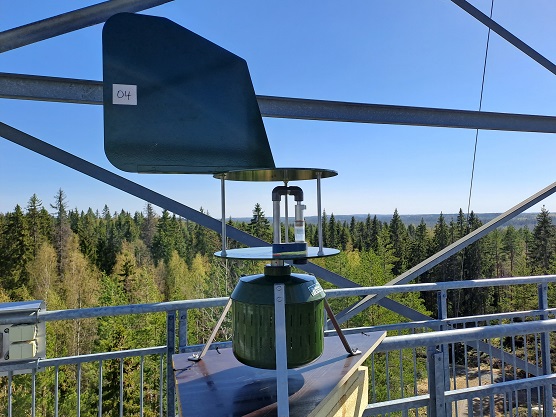
Cyclone sampler collecting airborne particles for DNA analysis. @Veera Norros
Background
Fungi play a fundamental role in the functioning of terrestrial ecosystems and in the global carbon cycle as the principal decayers of dead plant matter and symbionts of trees and other plant species. Fungi also include allergenic and pathogenic species posing significant threats to human health, agriculture and forestry. Most fungi disperse by airborne spores, which form one of the most common classes of bioaerosols. Their dispersal is called passive as they do not generate their own movement but are carried by the wind. However, fungi have evolved many features that affect the spore flight time and distance, allowing the control of dispersal over evolutionary timescales. Recent model simulations have suggested that spore size and timing of release can have dramatic effects on dispersal success. However, existing models lack realistic descriptions of important physical and biological processes. Moreover, validating model predictions against empirical data has been elusive due to a lack of observational data and large spatial scale of dispersion.
The SPORELIFE project aims to quantify fungal dispersal by combining existing data on life history traits with state-of-the-art atmospheric modelling. We validate species differences in dispersal predicted by models using local, regional and global DNA-based data sets on the species composition of airborne spores. We also develop, test and provide recommendations for applying airborne DNA methods and automated spore recognition instruments in environmental monitoring, helping to track and halt the ongoing biodiversity crisis.
Project aims
SPORELIFE combines new bioaerosol observation methods, species-specific life history trait data and a system for integrated modeling of atmospheric composition (SILAM) to develop a multidisciplinary understanding of fungal spore dispersion and factors determining spatiotemporal patterns in fungal community composition in the air.
Specific aims:
- Study variation in the airborne fungal community using metagenomics and metabarcoding approache
- Develop methods based on fluorescence spectroscopy, holographic imaging and machine learning for live identification of fungal spores in the air
- Develop integrated dispersion modelling, including also the spore production and release processes, for selected fungi, representing a range of species relevant for health, agriculture and nature conservation
- Assess the suitability of the new methods for policy-relevant fungal biodiversity monitoring at different scales and to give concrete recommendations for their implementation
Project results
The knowledge produced by SPORELIFE will help answer e.g. the following questions:
- What kind of dispersal strategies do different species of fungi display and how do different strategies affect the species’ ability to adapt to environmental change?
- When and how is it possible to map the fungal community of a given area using airborne eDNA? Can we deduce also distant occurrences of species by combining observations with atmospheric modelling?
- What are the more general application possibilities of airborne eDNA in the cost-efficient monitoring of biodiversity, and how should the sampling scheme be optimized depending on the target taxa and scale (global, national, local)?
- Can we produce operational spore forecasts comparable to the current pollen forecasts, which would help to control or minimize the impacts of crop pathogens and other harmful species?
More information
Other eDNA-related national and international projects at the Finnish Environment Institute:
Other links:
Contact
Project manager Veera Norros, Finnish Environment Institute, firstname.lastname@syke.fi, tel. 0295 251 459